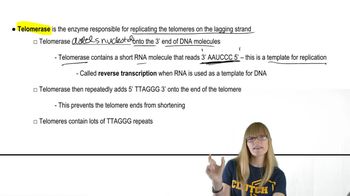Telomeres are composed of what type of DNA molecule?
Table of contents
- 1. Introduction to Genetics51m
- 2. Mendel's Laws of Inheritance3h 37m
- 3. Extensions to Mendelian Inheritance2h 41m
- 4. Genetic Mapping and Linkage2h 28m
- 5. Genetics of Bacteria and Viruses1h 21m
- 6. Chromosomal Variation1h 48m
- 7. DNA and Chromosome Structure56m
- 8. DNA Replication1h 10m
- 9. Mitosis and Meiosis1h 34m
- 10. Transcription1h 0m
- 11. Translation58m
- 12. Gene Regulation in Prokaryotes1h 19m
- 13. Gene Regulation in Eukaryotes44m
- 14. Genetic Control of Development44m
- 15. Genomes and Genomics1h 50m
- 16. Transposable Elements47m
- 17. Mutation, Repair, and Recombination1h 6m
- 18. Molecular Genetic Tools19m
- 19. Cancer Genetics29m
- 20. Quantitative Genetics1h 26m
- 21. Population Genetics50m
- 22. Evolutionary Genetics29m
8. DNA Replication
Telomeres and Telomerase
Problem 24
Textbook Question
In 1994, telomerase activity was discovered in human cancer cell lines. Although telomerase is not active in most human adult cells, all cells do contain the genes for telomerase proteins and telomerase RNA. Since inappropriate activation of telomerase may contribute to cancer, why do you think the genes coding for this enzyme have been maintained in the human genome throughout evolution? Are there any types of human body cells where telomerase activation would be advantageous or even necessary? Explain.
 Verified step by step guidance
Verified step by step guidance1
Understand the role of telomerase: Telomerase is an enzyme responsible for maintaining the length of telomeres, which are protective caps at the ends of chromosomes. Telomeres shorten with each cell division, and telomerase helps prevent this shortening in certain cells.
Consider evolutionary significance: The genes coding for telomerase have been preserved in the human genome because they play a critical role in ensuring the survival and proper functioning of specific cell types, particularly during early development and in cells that require extensive division.
Identify cells where telomerase activation is necessary: Telomerase is active in germ cells (sperm and egg cells), stem cells, and certain immune cells. These cells undergo frequent division and need telomere maintenance to prevent genomic instability and ensure their functionality.
Relate telomerase to cancer: Inappropriate activation of telomerase in somatic cells can lead to uncontrolled cell division, contributing to cancer. However, its regulated activity in specific cell types is essential for normal biological processes.
Explain the advantage of telomerase activation: Telomerase activation is advantageous in cells that require long-term division or regeneration, such as stem cells, because it prevents telomere shortening, which would otherwise lead to cell senescence or apoptosis.
 Verified video answer for a similar problem:
Verified video answer for a similar problem:This video solution was recommended by our tutors as helpful for the problem above
Video duration:
1mPlay a video:
Was this helpful?
Key Concepts
Here are the essential concepts you must grasp in order to answer the question correctly.
Telomerase Function
Telomerase is an enzyme that adds repetitive nucleotide sequences to the ends of chromosomes, known as telomeres. This process helps maintain chromosome integrity during cell division, preventing the loss of essential genetic information. In most somatic cells, telomerase is inactive, leading to gradual telomere shortening and eventual cellular aging. However, in certain cells, such as stem cells and germ cells, telomerase activity is crucial for sustaining their ability to divide and differentiate.
Recommended video:
Guided course

Telomeres and Telomerase
Evolutionary Conservation
The presence of telomerase genes in the human genome suggests evolutionary conservation due to their essential role in cellular function. Evolution tends to preserve genes that confer survival advantages, such as those involved in growth and repair. The maintenance of telomerase genes indicates that, despite their potential role in cancer when misregulated, they provide critical benefits in specific contexts, such as in stem cells, where prolonged cell division is necessary for tissue regeneration.
Recommended video:
Guided course

Overview
Cancer Biology
Cancer arises from the uncontrolled division of cells, often linked to mutations that disrupt normal regulatory mechanisms. Telomerase activation in cancer cells allows them to bypass the normal limits on cell division, contributing to tumor growth and immortality. Understanding the dual role of telomerase—beneficial in normal stem cells but potentially harmful in cancer—highlights the complexity of its regulation and the need for targeted therapies that can selectively inhibit telomerase in cancerous cells while preserving its function in healthy tissues.
Recommended video:
Guided course

Cancer Causes

 8:38m
8:38mWatch next
Master Telomeres and Telomerase with a bite sized video explanation from Kylia
Start learningRelated Videos
Related Practice
Multiple Choice
679
views
2
rank
